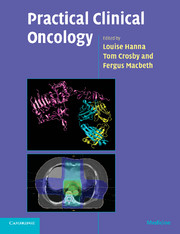Book contents
- Frontmatter
- Contents
- List of contributors
- Preface
- Acknowledgements
- Abbreviations
- 1 Practical issues in cytotoxic chemotherapy usage
- 2 Biological treatments in cancer
- 3 Hormones in cancer
- 4 Radiotherapy planning
- 5 Research in cancer
- 6 Oncological emergencies
- 7 Palliative care
- 8 Head and neck
- 9 Oesophagus
- 10 Stomach
- 11 Liver, gallbladder and biliary tract
- 12 Exocrine pancreas
- 13 Colon and rectum
- 14 Anus
- 15 Gastrointestinal stromal tumours
- 16 Breast
- 17 Kidney
- 18 Bladder
- 19 Prostate
- 20 Testis
- 21 Penis
- 22 Ovary
- 23 Body of the uterus
- 24 Cervix
- 25 Vagina
- 26 Vulva
- 27 Gestational trophoblast tumours
- 28 Lung
- 29 Mesothelioma
- 30 Soft tissue and bone tumours in adults
- 31 The lymphomas and myeloma
- 32 Central nervous system
- 33 Skin cancer other than melanoma
- 34 Melanoma
- 35 Thyroid
- 36 Neuroendocrine tumours
- 37 Cancer in children
- 38 Cancer of unknown primary
- 39 The use of radiotherapy in the treatment of benign conditions
- Multiple choice questions
- Multiple choice answers
- Index
- References
38 - Cancer of unknown primary
Published online by Cambridge University Press: 23 December 2009
- Frontmatter
- Contents
- List of contributors
- Preface
- Acknowledgements
- Abbreviations
- 1 Practical issues in cytotoxic chemotherapy usage
- 2 Biological treatments in cancer
- 3 Hormones in cancer
- 4 Radiotherapy planning
- 5 Research in cancer
- 6 Oncological emergencies
- 7 Palliative care
- 8 Head and neck
- 9 Oesophagus
- 10 Stomach
- 11 Liver, gallbladder and biliary tract
- 12 Exocrine pancreas
- 13 Colon and rectum
- 14 Anus
- 15 Gastrointestinal stromal tumours
- 16 Breast
- 17 Kidney
- 18 Bladder
- 19 Prostate
- 20 Testis
- 21 Penis
- 22 Ovary
- 23 Body of the uterus
- 24 Cervix
- 25 Vagina
- 26 Vulva
- 27 Gestational trophoblast tumours
- 28 Lung
- 29 Mesothelioma
- 30 Soft tissue and bone tumours in adults
- 31 The lymphomas and myeloma
- 32 Central nervous system
- 33 Skin cancer other than melanoma
- 34 Melanoma
- 35 Thyroid
- 36 Neuroendocrine tumours
- 37 Cancer in children
- 38 Cancer of unknown primary
- 39 The use of radiotherapy in the treatment of benign conditions
- Multiple choice questions
- Multiple choice answers
- Index
- References
Summary
Introduction
Cancer of unknown primary (CUP) is metastatic disease for which a primary site is undetectable at presentation (Varadhachary et al., 2004). It represents 2 to 6% of all invasive malignancies (Muir, 1995; Greco and Hainsworth, 2001). It is important to consider the possibility of potentially curable malignancies, such as germ cell tumours or lymphoma, and the workup for patients with CUP is therefore likely to include biopsy with immunohistochemistry to identify the cell lineage, if possible, and tumour markers. Investigations such as cross-sectional imaging or endoscopy are determined by the site of cancer, the patient's symptoms, and the general condition of the patient; however, an exhaustive diagnostic workup is not usually justified because it is unlikely to influence the outcome of treatment.
For those patients whose primary tumour is identified, treatment should continue as for that individual tumour site. For those patients whose primary tumour has not been identified after the initial workup, treatment is often empirical and based on research in patients whose primary tumour is known. Definitions in the medical literature of such tumours have been published. Examples include a biopsy-proven malignancy for a cancer that could not have originated at the biopsy site; no primary tumour found after a thorough medical history or physical examination, including breast and pelvic examination in women and testicle and prostate examination in men; and normal laboratory test results including the results of a complete blood count, blood chemistry, chest X-ray, CT scan of the abdomen and pelvis, and mammography or prostate-specific antigen (PSA) test (Varadhachary et al., 2004).
- Type
- Chapter
- Information
- Practical Clinical Oncology , pp. 442 - 448Publisher: Cambridge University PressPrint publication year: 2008



